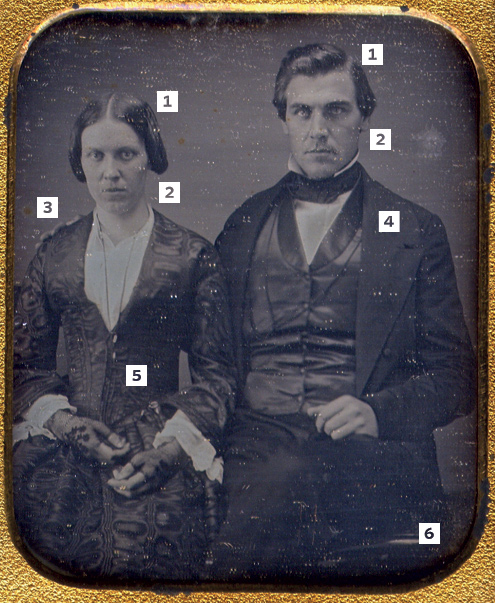Sign up for the Family Tree Newsletter Plus, you’ll receive our 10 Essential Genealogy Research Forms PDF as a special thank you!
Get Your Free Genealogy Forms
"*" indicates required fields

Digital cameras are portable and often store hundreds of photos at a time. They let people capture the seemingly endless details of life, from the important to the mundane, in the 21st century. Photography has come a long way since the 1840s and 1850s, the first two decades of commercially successful picture-taking. Customers paid from a quarter to a few dollars for a daguerreotype portrait, depending on the experience and location of the studio. Posing for portraits was reserved for major life events—family history milestones.
Sitting for a shiny metal daguerreotype required a subject to remain still from five to as long as 30 minutes, depending on the equipment used. To keep their clients motionless and prevent blurred images, daguerreotypists employed devices that clamped customers in place. Daguerreotypes are usually one-of-a-kind reverse images. The only way to copy a daguerreotype was to either sit for an additional image or to photograph the original.
In this portrait, owned by Jane Holt Wong, Wong’s second-great-grandparents Alfred Aldridge and Harriet White (Chadwick) Aldridge pose together in the early 1850s. The date for this picture relies on both photographic evidence and family history.
A 21-year-old Harriet Chadwick married 31-year-old Alfred Aldridge at St. Mark’s Church, in Warren, RI, May 19, 1851, according to the book Vital Records of Rhode Island, 1636-1850 by James N. Arnold, available on <www.archive.org>. The marriage was short. Harriet gave birth to two children, Florine (May 9, 1852) and Walter C. (June 15, 1853), before dying Aug. 2, 1853. This daguerreotype is the only known picture of the couple.
The facts seem to confirm this is a wedding photo, but Wong’s research raises new questions: She wants to know how a woman from Bristol, RI, whose father ran a hotel and a local stagecoach line, met a man who was living in Belvidere, NY, and whose father also operated a hotel. Was Aldridge a business contact of Mr. Chadwick’s or a guest at the hotel, or is there another connection? That’s a mystery the photo can’t solve.
Details:
- Harriet Aldridge wears her hair looped over her ears with a center part, in the style of the 1840s and early 1850s. Men in this period wore their hair long on top. Alfred Aldridge combs his hair back.
- Both have solemn expressions on their faces, which is common due to long sitting times for daguerreotypes. Harriet’s head tilts down so that she looks up at the camera. Alfred’s gaze is direct.
- Alfred rests a hand on Harriet’s shoulder in a protective fashion. This gesture often appears in wedding portraits.
- Alfred wears a silk vest with wide lapels and a double-breasted jacket. As was typical for men in the 1850s, his tie is a wide silk stock wrapped around his upturned collar.
- Harriet’s silk dress has an open front that shows a white chemisette, a common style around 1850. She wears white undersleeves at the wrist. The bodice fits snugly and has a point at the waist. She’s accessorized her outfit with fingerless net gloves called mitts. The thin chain around her neck may be for a pair of glasses or a watch.
- Cased images consist of a case, a mat that frames the image, the image itself, a glass cover and a strip of brass that holds the picture snugly in the case. The pebbly texture of the mat was common in the 1840s and early 1850s. Later daguerreotype mats were tooled with decorative details such as simple or elaborate floral patterns.
From the December 2010 issue of Family Tree Magazine
More great genealogy resources from Family Tree Magazine:
ADVERTISEMENT

